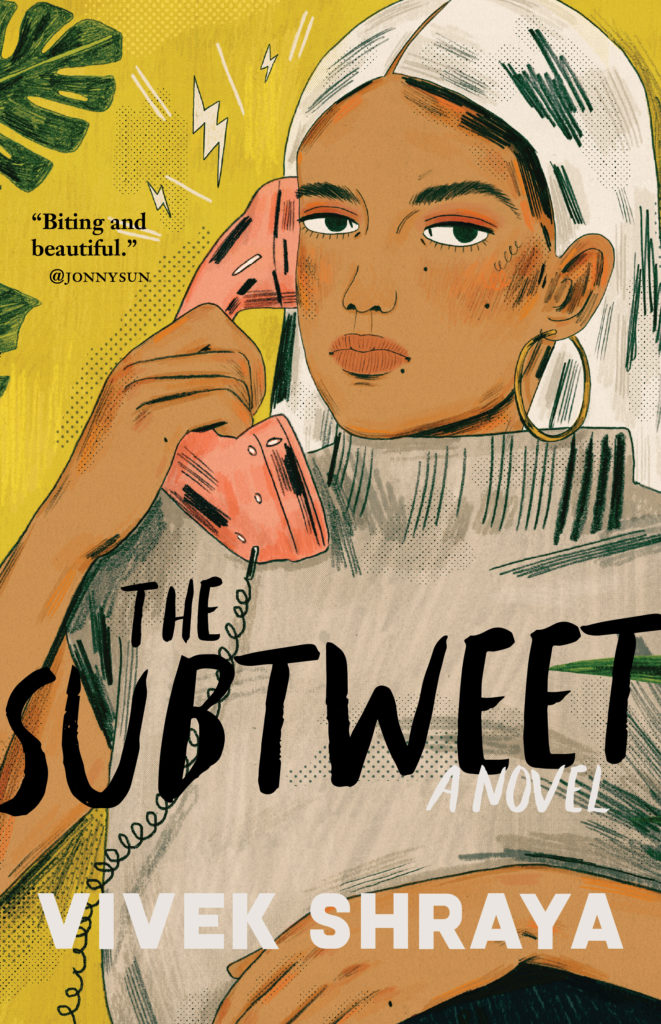Vivek Shraya’s prolific oeuvre spans a bevy of media, inhabiting a role as a contemporary Canadian Renaissance woman. Shraya’s multidisciplinary reach encompasses music, literature, film, visual art and theatre. Additionally, Shraya founded her publishing imprint VS. Books in 2016, a platform for Canadian writers of colour to receive mentorship in bolstering a debut manuscript, grant writing, and social media promotion.
Recently, Shraya published her second novel The Subtweet, which details the intimacy and inevitable downfall of a friendship between two distinguished females. The book follows fictional indie darling Neela Devaki, who is yearning for her songwriting to reach a larger audience. Enter internet popstar RUK-MINI, who covers one of Devaki’s songs and becomes a viral sensation. However, the two artists succumb to society’s tendency of pitting women against each other, and their comradery eventually becomes a clickbait firestorm of deceit and begrudgery. Here Shraya discusses the postmodern implications of her work, and how this racialized depiction of Internet infamy is reflective of toxic trends in culture.

What is your creative process when forming the central characters in The Subtweet? Are they amalgamations of traits and qualities from external sources, or is there a personal narrative that brings them to life as well?
“It’s a bit of both. When I was imaging the characters’ physical appearances, I tried to meld individuals who I have come across via Instagram alongside people who I know from my personal life. Certainly, in these characters there are aspects of my own thoughts and ideas, however, in this particular novel, I really tried to challenge myself to create personalities that were the opposite of me. For instance, Neela is very anti-social media, which is not necessarily how I feel, whereas RUK-MINI is very enthusiastic about grad school and learning theory, something I did not experience in my postsecondary endeavour. Ultimately, I tried to work against the notion of ‘write what you know’ in order to challenge myself.”
This novel can be seen as a postmodernist critique of the individual as both a corporeal being, and a digital entity. When do you feel these two can live in harmony, and when can that unity corrode into something more sinister?
“I firmly believe that when people engage with one another in the digital space in a manner similar to how they would in the physical world, that is when it is most fruitful and honest. I think the problem with social media is that when someone participates in any sort of discussion or debate with someone else, they tend to forget the other individual is a human being. There tends to be a disconnect between communicating with someone in a manner close to a real-life conversation. I believe it can become corrosive when we ignore an individual’s inherent humanity.”
I totally agree. Especially with these past couple of months, there has been an increase in people sharing their opinions about the current health crisis and social injustices that have taken the world by storm, and some have been quite surprising, to say the least.
“Exactly! However, I’ve tried to avoid chiming in on conversations online if I don’t agree with a viewpoint that is being articulated. With that being said, the Internet has also allowed a sense of self-importance to permeate throughout culture, as if every opinion is somehow valid and should be shared to their followers in a stream-of-conscious manner—this can be very problematic in a number of ways.”
The narrative highlights the tradition of pitting powerful women against one another, how do you feel this reflects monoculture as a whole?
“This is definitely a phenomenon that springs from a sexist and misogynistic culture, which is not really the fault of women at all. Society has always found ways to create this conflict between strong-willed, driven and autonomous female figures as if they are a threat to one another. This has been very evident in popular culture for decades. We love to compare women to each other, rather than recognize their unique artistry, which is not how their male counterparts are publicly received. Society is drawn to this notion of the catfight, even if there is no legitimacy to any reported beef and plays along with the notion that women are ‘catty’ or ‘bitchy’. The belief that there can only be one ruling woman in her area of expertise, especially in rap music, is toxic and undermines a bevy of distinct talents.
When creating a work of art, or a piece of literature, how does your main objective come about? Are they spur of the moment realizations, or an idea you ruminate on for a period of time?
“The idea for The Subtweet has been germinating since 2014. That said, I didn’t formally start writing the novel until about 2016. With novels, since there are many interlacing themes or contextual implications beyond the narrative, they take more time to gestate. On the flipside, my children’s book The Boy & the Bindi, was written on napkins during a lunch break. The same applies to making music, as some songs require a lot more labour to perfect, while others pour out of me during a recording session and take very little time at all.
As a POC, how important is giving women within this cultural minority a voice through your novel and previous artistic engagements?
“My art always has two agendas: a brown one, and a feminine one. There are very few books about genuine female comradery out there, and when you add in the racialized element of The Subtweet, the options become even more scant. I do feel a social responsibility to diversify whatever genre I’m stepping into, whether it is fiction, a graphic novel, or even making an album.
“I have a lot of respect for the primarily white culture I grew up on. Many of the musicians I admire—Sheryl Crow, Sarah McLachlan, and Madonna—are Caucasian. However, it is definitely important to give visibility to both minorities and queer folk, especially since the digital age has allowed for these once marginalized voices to be given legitimacy.
There definitely seems to be a push in society to variegate the personalities who are contributing to culture in unique ways.
“Exactly! I don’t think you need to belong to a certain ethnic or social group to admire the work of someone who is inherently different than you. I have personally benefitted from listening to music created by black individuals, and have become enlightened reading texts from indigenous authors. For me, it is not about creating art for the sole purpose of representing other brown people; I aim to reflect the real world, which isn’t completely white.”

